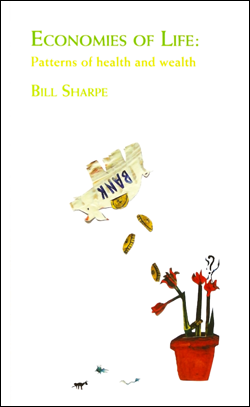Bill Sharpe: Economies of Life: Patterns of Health and Wealth

Illustrated by Jennifer Williams, 2010, 100 pages, Triarchy Press, Station Offices, Station Yard, Axminster, Devon EX13 5PF UK, triarchypress.com
The International Futures Forum (IFF), sponsor of these thought-provoking essays, is a global learning community in Aberdour, Scotland, that supports transformative responses to confounding challenges and new ways of restoring human capacity for effective action. Bill Sharpe, an IFF member, draws on psychology, science, and technology to explore systems thinking and tackle complex problems. Jennifer Williams, an IFF trustee, is a former GIA member and retired director of the London-based Centre for Creative Communities. So this well-written and beautifully illustrated publication is itself the result of creative collaborations and boundary-bending relationships.
The deceptively simple question driving these brief but paradigm-shifting essays is: “Can we use ecological thinking to understand how the arts work in society?” That question opens a chain of mind-expanding ideas. Ecological thinking, according to Sharpe, “involves seeing the patterns of life as a connected whole.” In other words, it requires us to look at the entire picture rather than at individual parts. Ecological thinking posits ecosystems that include all participating life-forms and the webs of relationships connecting them. Each individual is important in ecological thinking, but the primary focus is on the complex ecosystems binding individuals together.
An economy, defined by Sharpe as “a coordinated pattern of human activity mediated by a currency,” is an especially confounding set of relationships within an ecosystem. Sharpe points out that economic exchanges can take many forms, including “things” (e.g., bartering) and ideas (e.g., innovations), as well as money. Thus, Sharpe points out, ecosystems encompass many economies and varied forms of currencies.
Now for a big leap in Sharpe’s thinking: ecosystems have many economies, one of which he calls “the economy of experience.” This economy is especially important because the myriad relationships within an ecosystem create shared experiences among its participating life-forms. As Sharpe says, “When I explore my own life, I change the path of the world of all that I am part of.” Because all participants share in the life of the ecosystem, every individual performs some form of “dance between self and others,” which creates the economy of experience.
Within this economy of experience, Sharpe sees art as having a unique power, or “unreasonable effectiveness,” beyond rational explanation. He maintains that “through art, experience is put in motion between individuals sharing their cultural expression in different degrees.” In other words, “the value of art is precisely that it concerns itself with reflecting the experience of a particular life in its own terms and bringing that experience into the infinite conversation of shared culture.”
Because of its power to mediate human experience, Sharpe argues that art is the currency of the economy of experience. He recognizes that artists and art also circulate in the money economy, but he focuses instead on how the arts play an essential role as the currency of experience because “growth flows from relationships.” Sharing experience by creating and participating in the arts can stimulate individual change and produce new capabilities in the entire field of the relationships that sustain or change the ecosystem.
In this small volume Sharpe does not provide many pointers to the practical and policy applications of his new ideas. He offers the example of an organization called Watershed in Bristol, UK, explored in more depth in another IFF publication. As a space for cultural exchange, the organization acts as a “producer,” combining money and art in new ways and moving money to the margins to create enabling conditions transforming the lives of a wide variety of participants.
Sharpe recognizes that the practical and policy applications of his ideas require further development. As he also acknowledges, it is challenging to decenter the importance of money by using the language of economy and currency. Moreover, in the United States, it is confounding to try to shift public attention from individualism to shared experience, especially given the political and social power of money.
So what might this new way of thinking being developed by Sharpe and his colleagues at the IFF mean to arts funders? Since funders by definition deal primarily in money, should we ask ourselves what is the “right” relationship between the money economy and the economy of experience? Should we look at the health of the relationships that we are sustaining as well as the wealth we are transferring to individuals and organizations? Working at the nexus of the dynamic relationships that link art, experience, and money, we funders would do well to consider the “unreasonable effectiveness” of art in creating shared experiences.
